Reynold Brown at work
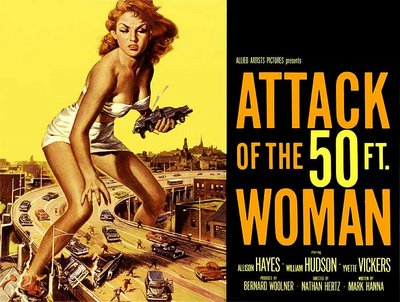
What James Bama was to Monster Kits, Reynold Brown was to movie posters. Born in Los Angeles in October of 1917, Brown started his career in illustration in 1937 as assistant to Hal (Tailspin Tommy) Forrest. He continued to work with Hal on his comic strips until 1941. From there he went straight to 6 years of illustrating for North American Avaiation and the U S Air Force, doing "cutaways" (or phantom views) of airplanes that showed their entire structure and inner workings. After his military stint he kept busy painting covers for dozens and dozens of covers for Bantam and Penguin pocket edition books, as well as tons of magazine illustrations for Life, True, Argosy, Saturday Evening Post, Boy's Life, Mechanix Illustrated and Outdoor Life just to name a few. His influences included J. C. Leyendecker, Dean Cornwell, N. C. Wyeth, and especially Norman Rockwell. In 1950 Universal's art director Mischa Kallis saw some of his work at an exhibition and asked him to do the poster art for the Gregory Peck B-picture A World in His Arms. Universal-International Brass was so impressed by his work that not only was he given a lot more --consistantly beating out other "well known" illustrators-- but he quickly received industry-wide repute as one of exploitation's secret weapons. During his long and prolific career he created the art for literally hundreds of movie posters, never truly getting the respect he deserved from the Hollywood advertising machine. In 1958 Albert Kallis hired Reynold to work for the upstart American-International Productions and it was there that his imagination and skills met their greatest test. AIP lived or died based on the appeal of their advertising, and he did over forty posters for movies that were really more derserving of box-office oblivion...A good portion of them done with short notice and over a single weekend (The AIP special).
Reynold could conjure up an iconic powerhouse image of chaos and mayhem with a stunning level of detail like nobody's business. Even his charcoal sketches and comps were generally better than a lot of other top artists' best efforts.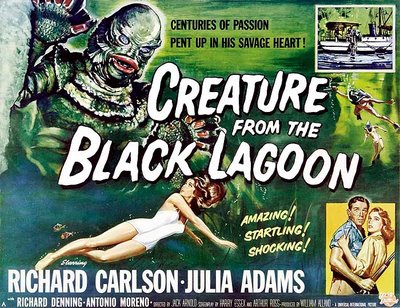
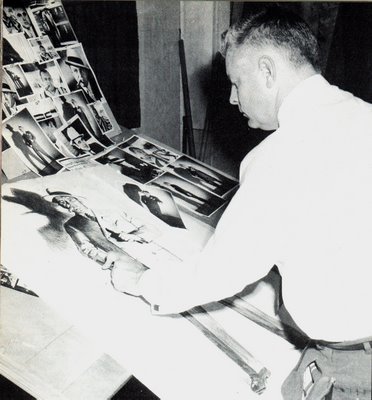
Reynold, who had an incredible flair for portraiture, here works up a comp for the poster campaign for the 1959 Allied Artists' film Al Capone.
Not only did he do posters for films well remembered...
( AIP's The Pit and the Pendulum from 1961. The poster art for the one sheet and the insert.)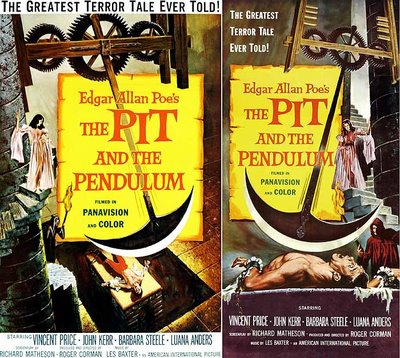 (What's he gonna throw next?)
(What's he gonna throw next?)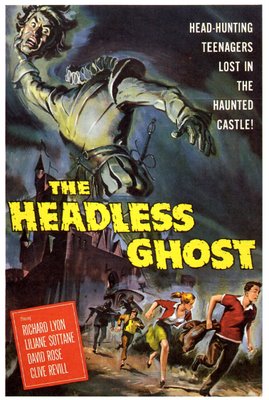 ...but he painted posters of plenty for lesser-remembered films ,too. (This poster from 1959's The Headless Ghost is a good example of an AIP weekend rush job special, where Reynold found it a necessity to use a looser style just to get the work turned in by monday.)
...but he painted posters of plenty for lesser-remembered films ,too. (This poster from 1959's The Headless Ghost is a good example of an AIP weekend rush job special, where Reynold found it a necessity to use a looser style just to get the work turned in by monday.) Here Brown exhibits his photographic style with the poster art yet another "classic", 1957's Love-Slaves of the Amazon. (Actually Curt "The Wolfman" Siodmak wrote, produced and directed this little testosterone-fueled fantasy.)
Here Brown exhibits his photographic style with the poster art yet another "classic", 1957's Love-Slaves of the Amazon. (Actually Curt "The Wolfman" Siodmak wrote, produced and directed this little testosterone-fueled fantasy.)
Reynold's drawing skills were every bit as as precise as his paintings were rife with detail.
Below is a pencil rough (42 1/2 " x 27 1/2") he did for Goliath and The Barbarians --AIP's first foray in the Barbarian movie genre in 1959. Very comic-booky in it's presentation, though more modern in it's execution than a lot of comics at that time. (In fact, some stylistic elements of this piece seem reminiscent --or vice-versa-- of work done in the 1970s by comic book greats like John Buscema, John Romita and Neal Adams .)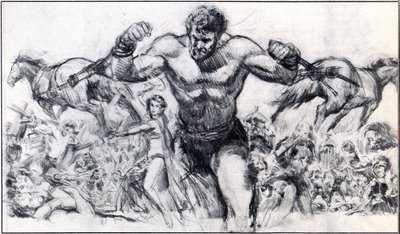
A Gallery of original Brown paintings. 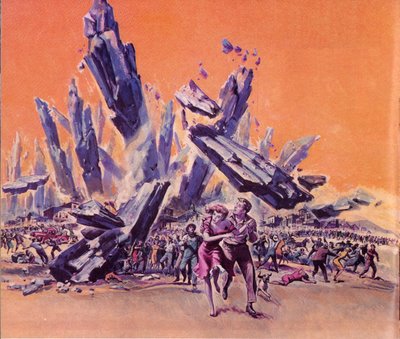 The original 241/2" x 241/2" painting for Universals' 1957 offbeat oddity The Monolith Monsters. (Painted in the six-sheet format) For the medium on this piece Brown used goauche on illustration board.
The original 241/2" x 241/2" painting for Universals' 1957 offbeat oddity The Monolith Monsters. (Painted in the six-sheet format) For the medium on this piece Brown used goauche on illustration board.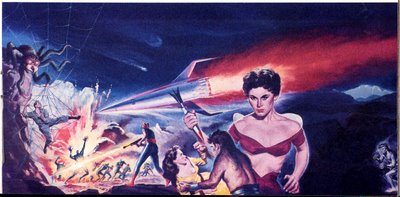 The Original Billboard-format 24 sheet painting for Allied Artists' World Without End, also from 1957.
The Original Billboard-format 24 sheet painting for Allied Artists' World Without End, also from 1957. Here's the 8" x 211/2" original art that Brown prepared for This Island Earth in 1954. Again, here he used goauche on illustration board.
Here's the 8" x 211/2" original art that Brown prepared for This Island Earth in 1954. Again, here he used goauche on illustration board.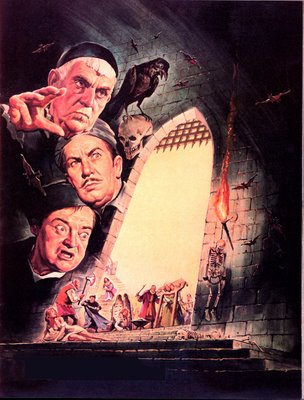 More great portraits, this time of the "Bat-pack" in their prime, in the original art for AIP's 1964 production of The Raven.
More great portraits, this time of the "Bat-pack" in their prime, in the original art for AIP's 1964 production of The Raven.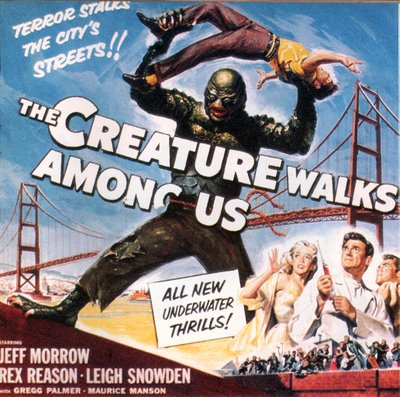 Much to the chagrin of the illustrator the type in those days was very often applied directly to the original art. The poster art Brown prepared for Universal's luckluster 1956 effort The Creature Walks Among Us was no exception. Note that half of the "G" has dropped off of the word "Among".
Much to the chagrin of the illustrator the type in those days was very often applied directly to the original art. The poster art Brown prepared for Universal's luckluster 1956 effort The Creature Walks Among Us was no exception. Note that half of the "G" has dropped off of the word "Among".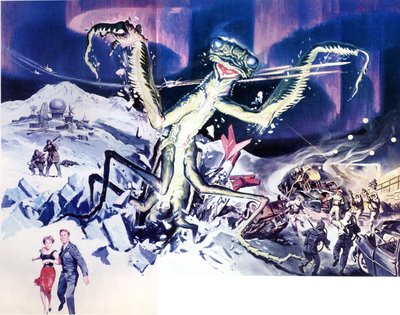
This painting Brown did for The Deadly Mantis was used for the film's 81" x 81" six sheet as well as the 22' x 28' lobby card. Noboby else caputured the exaggerated comic-book feel of 1950s science-fiction and paranoia like he did.
( Let's see...What happens in The Deadly Mantis again? He breaks out of the ice, kills a guy in a parka, crashes an arctic base and gets shot at by some soldiers in the snow, wrecks some planes, gets shot at by jets, and eventually has an encounter with some guys in radiation-type suits at a gas filled tunnel trashes a few cars. Hmm...Yep...It's all there.)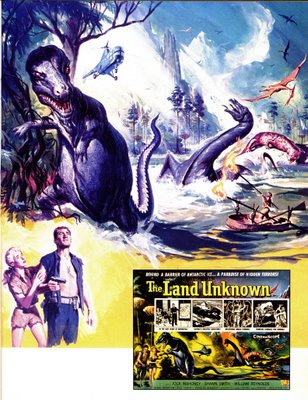
The art for the six sheet of Universal's 1957 Dinosaur-suit romp The Land Unknown.
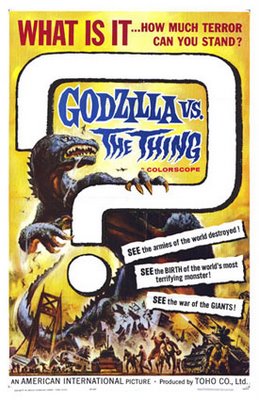
Here's Brown's amazing original painting as it was prepared for AIP's Godzilla vs The Thing (1964), plus the one-sheet, so you can see how much art was lost when it was printed...And this alternative version that was used in some of the pressbook art (but in black & white). As much as I love these paintings I've always kinda wondered just what was going on with ol' G's legs.
Like James Bama, Reynold Brown was as proflic a painter as he was versatlie and talented draftsman. The whole time he was doing movie posters he continued to work on other projects including book covers, record jackets and teaching at Art Center College of Design. He managed to live comfortably but he never got rich (In fact, for a standard 350$ fee he would deliver up to as many as four different paintings and revisions--all in a weeks time).
Contemporary movie poster painter (Star Wars) Drew Struzan found out just how much industry notariety Brown had once he graduated school and started making the studio rounds:
"Everywhere I went his name came up --and still does-- because he was one of the standard-bearers of his time. He is probably the only illustrator who had a reputation as a Hollywood artist."
Reynold eventually dropped out of the Hollywood rat-race and retired in realitive seclusion.
He suffered a stroke in 1976 but was able to retrain himself enough to do some powerful drawings and beatiful landscape paintings of the Nebraska countryside where he settled in 1983 and remained until his death in 1991. He did live long enough to see just how much appreciation for his work had grown, and how collectable the posters he painted for such low wages had ultimately become.
My thanks to those who helped make this post possible, including Fredrick Clarke, Stephen Rebello and Drew Struzan, and especially Reynold Brown.
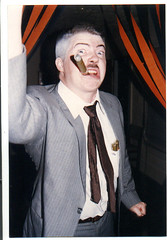

12 Comments:
There's an outstanding documentary about Reynold Brown out there called The Man Who Drew Bug-Eyed Monsters. AMC usually runs it during their periodic "Monsterfest" programming.
12:34 AM
well written, superbly researched, and chock full of amazing art.. you've outdone yourself.
thanks for the new post to this astounding blog of yours.
4:11 PM
The Man Who Drew Bug-Eyed Monsters is worth checking out if you can. Great piece here, Clay. Nice to see all the work without the text slapped over it.
How I'd love to own one of those.
maybe with the success of the Basil Gogos book, someone will tackle putting one together on Reynold Brown.
6:10 PM
How does old friend catch up with you without having to create a blog? Think early 1990's - ha- I knew you when....would like to catch up - though it does not seem like you have changed all that much. You may not remember - but I do. Hooray and Well Done on all your successes. Could I take a chance to leave an email address on a blog?
Helen
4:03 PM
You say that the same art used for the 6-sheet of the Deadly Mantis was also used for a 22 x 28 lobby card? I never knew that...22 x 28 is pretty big for a lobby card...would that be a half sheet? The only half sheet I've ever seen has the Joeseph Smith art on it (with the mantis climbing the Washington Monument, which a lot of people mistakenly think was also painted by Reynold Brown). Maybe there's a "B" style halfsheet I haven't seen? The art Brown did for the Deadly Mantis 6-sheet is one of my favorite paintings (not just by him, but by anyone!), I'd sure love to get a poster featuring the art. I figured I could probably never find nor afford a Mantis 6-sheet (much less have wallspace for it) so this is good news.
Now for some bad news -as I'm sure many of you are aware, the publisher of Illustration magazine has been planning on doing a coffee-table size book on Reynold Brown - they were advertising this quite a bit a couple of years ago, but it never came out. I contacted the editor/publisher of Illustration magazine and asked him what was up with the Reynold Brown book. He said he laid out all the graphics, but has not had time to write it (and doesn't know when he will). So it sits in limbo.
8:09 AM
Wow Dave, that IS bad news...maybe he'll eventually hand it off to someone who'll help with more time on his hands!
And HELEN, Great to hear from you and sure, you could leave your email adress here and I could be delete it before it's "published". But don't do it 'til like Monday as I'll be out-and-about this whole weekend. (...But I've had the same phone number for like 16 years if you still have it!)
11:06 AM
The Deadly Mantis art was used for the six sheet and the window card , not a 22" x 28".
The alternative Godzilla art was used as a 22" x 28" (half sheet) though as well as in the pressbook. Man did they lose a lot when they turned that art into the poster.
1:33 PM
I am one of the granddaughters of Reynold Brown and I am very impressed with your blog on my grandfather.
As for the book, I have pasted the excerpt from the illustration magazine site.
Adeline
Reynold Brown: A Life in Pictures by Daniel Zimmer and David Hornung is now in China and is being printed as I write this. The book should be complete and back in the States before the end of February. Please watch my websites for updates on this fantastic new book. The book will be 224 pages, hardcover, printed in full color, 9 x 12 inches in size. The regular edition will be $39.95 plus $5.00 shipping. The DELUXE edition will be $100.00, and comes in a slipcase with a special DVD and a bookplate signed by the authors, as well as Reynold Brown’s wife Mary Louise Tejeda Brown. This edition is limited to only 100 copies, so it will sell fast!
excerpt from: http://illustrationmagazine.wordpress.com/2008/12/15/reynold-brown-a-life-in-pictures/
9:33 PM
Yes indeed, the Reynold Brown book is NOW SHIPPING from my website, http://www.theillustratedpress.com
10:58 PM
With regards to Raven, my father's favorite trio of actors to paint. Vincent Price, Boris Karloff and Peter Lorre. Nice site by the way. To answer one of the questions above, original works are occasionally sold from the families extensive collection. The family is working with Fred Taraba, http://www.tarabaillustrationart.com/
from Franz Brown, the artist's son.
11:33 AM
We have the privilege of having 3 of Reynold Brown's paintings, a beautiful trio of Western pictures showing a boy going off from his parents, then the father searching for him, then the father bringing the injured boy home. It's absolutely gorgeous, and has been a joy to our family for many years
3:24 PM
Is there any way to contact Reynold Brown's relatives or someone who is in charge of his estate? I am trying to use a 1945 piece of art that was used in an Aviation magazine but the current owners of the Mag are proving a bit @nal about it. Apparantly because of the age if I get permission from the artist (or in this case his estate) I can bypass the magazine and use this 65 year old image on my site, without fear of copyright infringement (which I'm not so sure about anyway due to the age).
5:19 PM
Post a Comment
<< Home